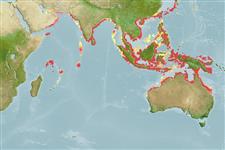Common names from other countries
Environment: milieu / climate zone / depth range / distribution range
Ecologie
marien; zoet water; brak water; amfidroom (Ref. 51243); diepte 10 - 13 m. Tropical; 31°N - 25°S, 52°E - 152°E
Indo-Pacific: Persian Gulf eastward to Myanmar, Andamans and Penang; Taiwan south to Arafura Sea (Ref. 9819), the northern coasts of Australia and Papua New Guinea; Sarawak; a record from the Bonin Islands; presumably the Philippines; perhaps not eastward to the Hebrides, etc.
Lengte bij maturiteit / Grootte / Gewicht / Leeftijd
Maturity: Lm 16.6 range ? - ? cm
Max length : 27.0 cm SL mannelijk / geslacht onbekend; (Ref. 30691); max. gerapporteerde leeftijd: 4 Jaren (Ref. 127396)
Dorsale stekels (totaal) : 0; Anale stekels: 0; Anale zachte stralen: 32 - 39. Belly with 23 to 26 keeled scutes from isthmus to anus. Tip of snout above level of eye center, usually about level of upper rim of eye. Maxilla short or moderate; first supra-maxilla small, oval. A dark blotch behind upper part of gill opening.
Coastal pelagic (Ref. 68964). Presumably schooling, inshore and entering estuaries. More precise data needed, based on correct identifications. If this is the species being referred to in Ref. 6841, then the principal food of the young would be prawns and copepods, supplemented by polychaetes and amphipods.
Whitehead, P.J.P., G.J. Nelson and T. Wongratana, 1988. FAO Species Catalogue. Vol. 7. Clupeoid fishes of the world (Suborder Clupeoidei). An annotated and illustrated catalogue of the herrings, sardines, pilchards, sprats, shads, anchovies and wolf-herrings. FAO Fish. Synop. 125(7/2):305-579. Rome: FAO. (Ref. 189)
Status op de Rode Lijst van het IUCN (Ref. 130435)
CITES (Ref. 128078)
Not Evaluated
Gevaar voor de mens
Harmless
Gebruik door de mens
Visserij: commercieel
Tools
Speciale rapporten
Download XML
Internetbronnen
Estimates based on models
Preferred temperature (Ref.
115969): 25 - 29.3, mean 28.6 (based on 1528 cells).
Fylogenetische diversiteitsindex (Ref.
82804): PD
50 = 0.5000 [Uniqueness, from 0.5 = low to 2.0 = high].
Bayesian length-weight: a=0.00617 (0.00467 - 0.00813), b=3.04 (2.97 - 3.11), in cm Total Length, based on LWR estimates for this species (Ref.
93245).
Trofisch niveau (Ref.
69278): 3.5 ±0.51 se; based on food items.
Weerstandsvermogen (Ref.
120179): Hoog, minimale populatieverdubbelingstijd minder dan 15 maanden (K=0.66-1.32; tmax=4).
Fishing Vulnerability (Ref.
59153): Low vulnerability (16 of 100).
